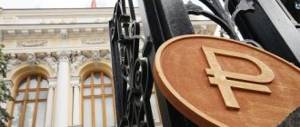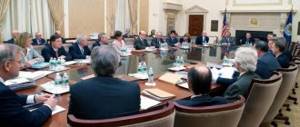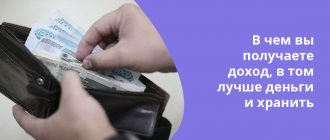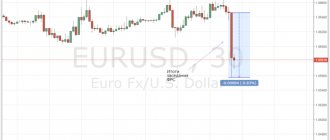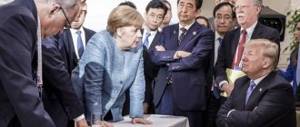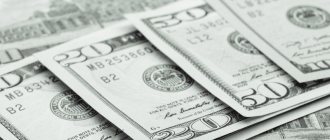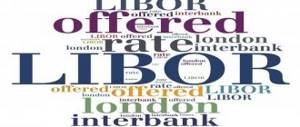The US Federal Reserve System (FRS) raised the base interest rate to 0.25–0.5% for the first time in nine years. Prior to this, for seven years the rate was at a record low for America at 0–0.25%. The Federal Reserve had to lower it during the 2008 crisis to support the national economy. Now the US economy, according to the Fed, has stabilized: unemployment is falling, the real estate market has picked up.
More signs of inflation
Stocks continue to spiral nervously as the Fed behaves like a cornered animal trying to downplay inflation risks by propping up a mega "everything bubble" based on inflation tools.
The "official" CPI inflation measure rose to 4.2% in April, the fastest rise since 2008 and twice the Fed's mandate. The regulator says this is due to the deflationary trends of COVID in 2021, which made this relative rise in inflation "expected", "temporary" and soon "contained". But we've heard this before.
Meanwhile, U.S. producer prices rose 6.2% in the same month, the highest since 2010, as core inflation, which excludes energy and food, posted its highest rise since 1981.
In energy and food, prices for everything from ethanol to canola and corn, from milk, chicken wings and lean pork to beef and coffee are skyrocketing at high double digits.
So, if you think inflation is still a matter of debate, the facts once again tell us that it is here. And regarding inflation in risk asset markets, this is a clear bubble narrative.
The discount rate and its impact on Russia
The Central Bank of the Russian Federation will not be able to avoid the negative effects of the strengthening of the US currency and the growth of the discount rate. This fact will lead to problems with the build-up of international reserves, which have decreased to $365 billion from an amount of over $500 billion.
Experts believe that, of course, rising rates will have a negative impact on the economy of our state. But this influence will not be as strong compared to other developing markets, since, as a result of sanctions, the Russian Federation is no longer so strongly connected economically with the United States.
The Bubble Narrative: Stakes Matter
As for asset bubbles, they are the result of simple cause and effect.
If you want to know why stocks are inflated to levels that can rattle bulls or bears, the following betting chart will give you the answer.
History and mathematics confirm that all bubbles are fueled by debt, and when debt is cheap, bubbles expand fatally.
The following interest rate picture, which tracks the cost of debt, speaks a thousand words about the power, as well as the danger, of cheap debt fueled by the Fed's artificial suppression of rates.
Simply put, interest rates matter.
As the aforementioned 1980s rate spike confirms, US interest rates were once 19% when debt levels were low. But now try to imagine that current sovereign bonds, real estate bonds or corporate bonds would have to pay off debt at these rates. Could the Fed go in this direction intentionally to combat the inflation discussed above? They can't, couldn't and won't.
Raising rates will be positive for the bond market, and no less so for the stock market. So, if you're at all concerned about intentional rate hikes: don't be. The Fed simply cannot allow this to happen.
Frankly, even at 5%, these markets and economies will go bankrupt.
This chart also shows that for every recession (gray vertical lines at the top), the Fed has been able to cut rates to re-stimulate markets. This is their only real motive, despite what Fed officials say about their role in supporting the real "economy."
The Fed serves the market, not the economy.
The Fed's deliberate pattern of market support, and therefore distortion, is now non-negotiable and boils down to this:
- “Stimulate” markets with low rates;
- When things are going well, try raising the stakes cautiously;
- When market bubbles burst anyway, rebuild them again by lowering rates.
In short, cutting rates saves dying markets.
Arsenal is exhausted
But here's the rub: what happens when there is no more room to cut rates? Well, this is exactly the situation the Fed (and other central banks) find themselves in now—their arsenal has been exhausted.
The graph above makes this point clear; these are far from hypotheses and theories: there are no rates that need to be lowered, and, therefore, what “worked” in the past simply will not work tomorrow.
For example, in the early 1980s, Fed rates fell from 19% to 8%; in 1989 they lowered rates from 10% to 3%; and during the dot-com bubble of the early 2000s, rates fell from 6% to 1%. See the pattern? With each "accommodative" rate cut, more bubbles appeared, which led to more bubbles, which meant more rate cuts to "accommodate" the markets.
In 2008, of course, the Fed responded to the Great Financial Crisis with, you guessed it, another rate cut—all of which helped “recover” markets (from real estate to tech stocks) amid cheap debt. Unfortunately, however, when we look to the far right of the chart above, we again see that there are no rates left to cut. Powell, of course, knows this too. He's far from a fool. That's why he's been trying so hard in 2021 to raise rates and scale back his quantitative easing program, so he'll have something to "cut" when markets fall again.
Of course, attempts to raise rates against a national and global backdrop of historically unprecedented government and corporate debt have not been successful for Powell, as we saw with the subsequent market surge in late 2021 or the 2019 repo crisis.
What is the conclusion? It's simple: the Fed can't go for a hawkish rate hike without bringing markets—and economies—to their knees; by extension, they now have nothing to “cut” when the current bubble of “everything” bursts. And that's the real problem.
The solution is worse than the problem
As for the solution, the tragic thing is that the Fed's only option is an even bigger problem.
That is, if the Fed wants the markets (and their job security) to breathe freely, they no longer have the aforementioned rate-raising-then-cutting pattern at their disposal, which means they now have no choice but to continue as usual keep rates near the zero limit indefinitely.
But the only way to keep rates “under control” at a minimum level is to buy bonds that no one else wants, in order to keep their prices high and therefore lower yields and rates.
This, of course, costs money, and as we all know, the only "money" the Fed can spend is the money they create out of thin air - the very money (and policies) that lead to the inflation they talk about mentioned above, namely severe inflation.
Regarding this fake money that the Fed is printing nonstop, the regulator's desperation is obvious, as evidenced by the M2 money supply.
The Fed is so ashamed of this decision to print money that they have stopped reporting weekly M2 data, and frankly have even stopped reporting monthly since March.
This, of course, says a lot. The Fed literally has something to hide, and that never bodes well, does it?
Central banks are stuck between an inflationary hammer and/or a market-killing hard place
So the Fed can continue to use fiat currencies to pay for yield curve control (YCC) to keep rates down and therefore keep markets from collapsing completely. This requires not billions, but trillions.
The correlation with central bank balance sheet expansion (i.e. money supply) and rising markets is now beyond doubt.
But to continue this open farce of printing money to "inflate" bubbles of risky assets from bonds to beach houses, the inflationary effects of such fake money (and desperate) monetary policy are now impossible to ignore, despite being openly laughable excuses and reassuring forecasts from Powell and others like him.
Whenever markets get shaky, the Fed prints money (think March 2021), and whenever the Fed thinks markets are "strong" (like June 2021) and can be tightened (i.e. print less), markets decline and thus the Fed fires up the printing presses again (July 2021).
Do you see a correlation? More importantly, do you now see the puzzle that the Fed created itself? That is, they have two options:
- let markets die (by hawkishly tightening the money supply needed to control rates);
- allowing Main Street-crippling inflation to increase (by gently adjusting markets to unlimited paper money).
What choice do you think they will make, given that the Fed is bowing to markets rather than people?
In other words, expect more money printing and yield curve control - and therefore more inflation and fiat currency depreciation.
Once you accept the true nature of the Fed and the true priorities of the market, then making behavioral (and therefore policy) forecasts about the Fed becomes incredibly easy.
The discount rate and its impact on Europe
An increase in the discount rate may have a negative impact on the economic situation of the EU countries; this may cause increased volatility and unpredictability of the market.
The head of the European Central Bank and other policymakers believe that the recent wave of volatility in world markets will have a strong negative impact on the recovery of the European economy.
What should markets expect?
At the time of writing this article, there is panic in the markets, from exchanges in the US and Europe to Australia and Japan.
Why? Because no matter what Powell, the CPI scale, or other financial puppets say, forward-looking markets are expecting higher inflation (from money printing to supply chain shocks).
At the same time, those same markets are hanging on Powell's every word. This is further proof that today's modern and horribly unnatural markets are driven entirely by the Fed rather than by old (and now extinct) capitalist principles such as, say, natural supply and demand or legal price discovery. You can simply say that the Fed is the market.
At the moment, there is a real fear that Powell will hint at a reduction in quantitative easing, which will provoke another hysteria on Wall Street.
Meanwhile, as markets nervously await the Fed's next carrot or stick (dove or hawk), they can't help but ignore the S&P 43 earnings ratio (historical average of 17-20), which screams overvaluation but could actually lead to even more high stock prices (bubbles) until the Fed stops printing money and cutting interest rates.
But if Powell can still offer Wall Street the stick of raising rates rather than the carrot of yield curve control, any future rate cuts and money supply "accommodation" will cause markets to simply collapse.
So, what will it be: carrot or stick? Dove or Hawk?
Meanwhile, the stock faces a host of other headwinds. The S&P's dividend yield fell to 1.5%, below even the artificially depressed 10-year Treasury yield of 1.66%. Will investors flee stocks to the “safety” of bonds, causing this outflow to push down stock prices?
At the same time, the number of stimulus payments is being reduced, as is the projected extension of unemployment benefits. If this support is reduced, consumer demand and therefore corporate earnings will feel the pressure, as will stock prices.
The discount rate and its impact on Japan
Inflation here is also almost zero. Therefore, if the Fed refuses to tighten policy, sooner or later there will still be a significant difference between US and Japanese rates.
According to some experts, raising the Fed rate will make owning the American currency more attractive. But at the same time, the weakening of the Japanese currency will negatively affect the share of profits of importers and increase the share of profits of large exporters.
